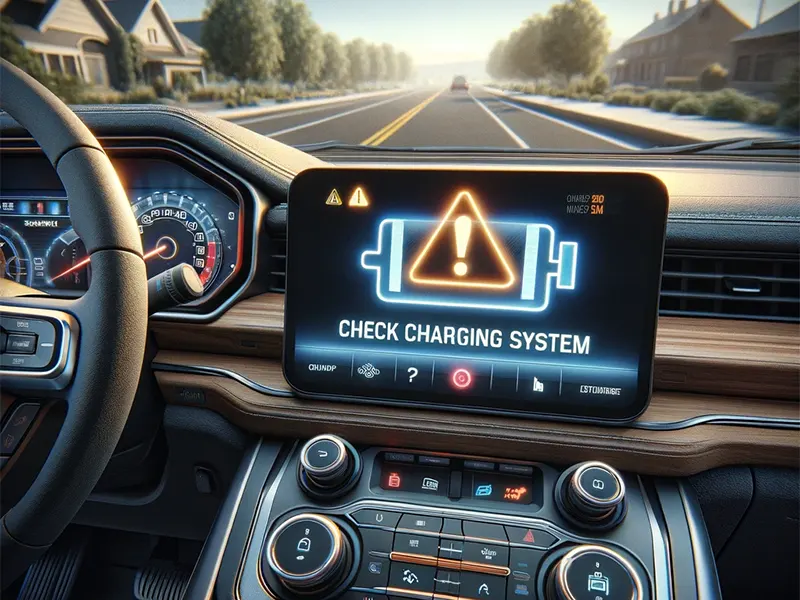You’re driving along in your Ford Explorer when suddenly the “Check Charging System” warning light illuminates on the dash. What does it mean and what should you do?
The charging system is critical for powering your vehicle’s electronics and keeping the battery charged. Ignoring that warning light could leave you stranded when the battery runs out of juice. Let’s take a closer look at what might cause this light to turn on so you can get back on the road.
Problem Explanation
The charging system generates and regulates electricity to power your vehicle’s ignition and electrical components while also charging the battery. It consists of the alternator, battery, voltage regulator, and serpentine belt working in concert.
When the “Check Charging System” light illuminates, it indicates there is an issue with the charging system. Potential symptoms include dimming headlights, flickering interior lights, and difficulty starting the engine. Prompt diagnosis and repair is recommended to avoid being left without a functioning charging system.
Understanding the Charging System
Components
- Alternator – Converts mechanical energy into electrical energy, generating power to operate the electrical system and charge the battery while the engine is running. Typical output is around 135-150 amps in the Ford Explorer.
- Battery – Provides power to start the vehicle and run electronics when the engine is off. Needs to be kept charged by the alternator while driving.
- Voltage regulator – Controls and regulates the alternator’s voltage output to maintain proper system voltage (about 13.5-14.5V).
- Serpentine belt – Transfers rotational force from the engine’s crankshaft to operate accessories like the alternator.
Function
When the engine is running, the serpentine belt rotates the alternator to generate electricity. This powers the vehicle’s electrical system and recharges the battery. If the battery loses charge, the vehicle will eventually fail to start due to lack of power.
Symptoms
“Check Charging System” light accompanied by dim headlights, flickering interior lights, weak battery cranking, and difficulty starting point to an issue with generation and regulation of electricity.
Potential Causes for the Light
There are a few key components that could trigger the “Check Charging System” warning:
Alternator Issues:
- Failure: Common alternator failures include worn carbon brushes, failing diodes or rectifiers, and problems with the internal voltage regulator. This can lead to zero or low amperage output.
- Slipping belt: The serpentine belt may become loose or worn out over time, causing it to slip on the alternator pulley and limiting electricity generation.
Battery Issues:
- Age and degradation: Batteries gradually lose capacity over their 3-5 year service life. An old weak battery struggles to accept a charge.
- Corrosion: Corroded battery terminals or cables add resistance to the charging circuit, impeding the battery’s ability to reach a full state of charge.
Wiring Problems:
- Loose connections: Damaged or disconnected wires between components interrupt vital communication.
- Blown fuse: Electrical overload can blow the alternator or regulator fuse, disrupting charging ability.
Other Causes:
- Faulty voltage regulator: An internal regulator failure can prevent proper charging voltage control.
- Instrument cluster issues: Rarely, a faulty “Check Charging System” circuit causes an erroneous warning light.
Diagnosing the Problem
Pinpointing the cause requires thorough inspection and testing:
- Visual inspection: Check for loose, broken, or corroded connections, frayed wiring, belt wear or slippage. Look for physical damage to components.
- Voltage testing: Use a multimeter to check battery voltage at rest and while running. Also verify alternator output by measuring voltage directly at the alternator or battery terminals with the engine revved to 1500-2000 rpm. Compare to Ford’s specifications.
- Professional diagnosis: For accurate troubleshooting, have the charging system tested by a certified Ford technician. They have the specialized tools and software to assess alternator output, voltage regulation, and pinpoint faults.
Solutions and Repair
- Alternator replacement: Replacing a failed Ford Explorer alternator with a new or refurbished one typically runs $350-850 for parts and labor. Only use replacement parts that meet Ford’s specifications.
- New battery: Plan on replacing an aging weak battery showing difficulty holding a charge. Cost starts around $150. Ensure the new battery’s cold cranking amps (CCA) meet vehicle requirements.
- Wiring repair: Properly diagnose and repair loose body or battery cables, damaged wiring harnesses, blown fuses, etc. Leave complex electrical repairs to professional technicians to prevent further issues.
- Address other faults: Voltage regulators, instrument clusters, and other electronics will require Ford service center diagnosis and repair.
Preventive Maintenance
- Inspect annually: Check belt condition, battery terminals, wiring, and scan for trouble codes during routine maintenance.
- Ensure proper battery care: Clean corrosion from posts and cables to maintain conductivity. Check water levels. Store in a cool area away from extreme hot or cold.
- Consider professional service: Many Ford dealers offer multi-point inspections to spot potential problems early, including charging system analysis.
Stay proactive with basic maintenance, and don’t ignore warning signs like flickering headlights or hard starting. Identify and repair Ford Explorer charging system issues promptly to avoid being left stranded!

John Smith, a Los Angeles-based car specialist and automotive writer, boasts over 20 years in the industry. With a background as a master technician and a decade-long writing stint at notable automotive publications, John now shares his expansive knowledge on CarFinite, simplifying car maintenance for readers.

